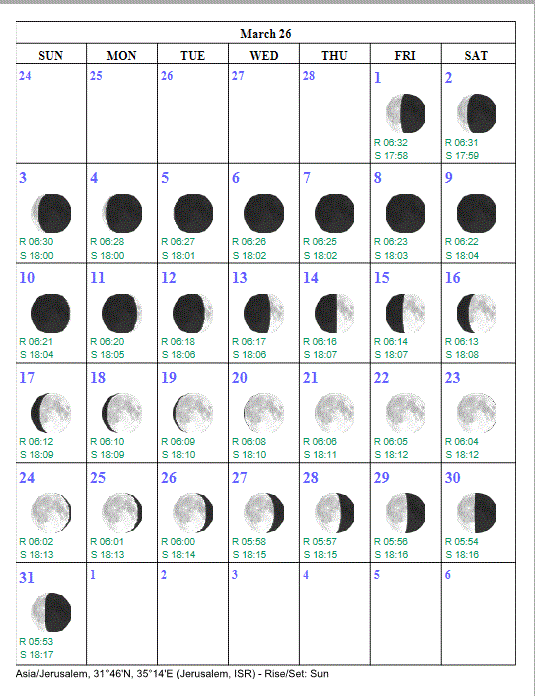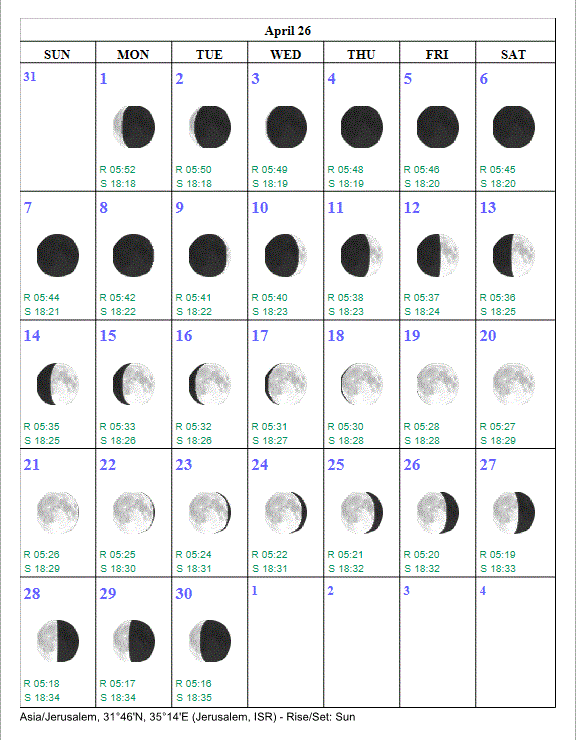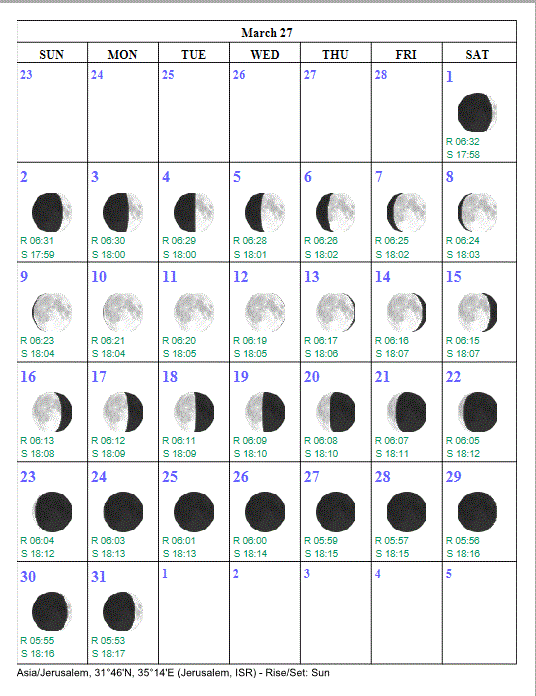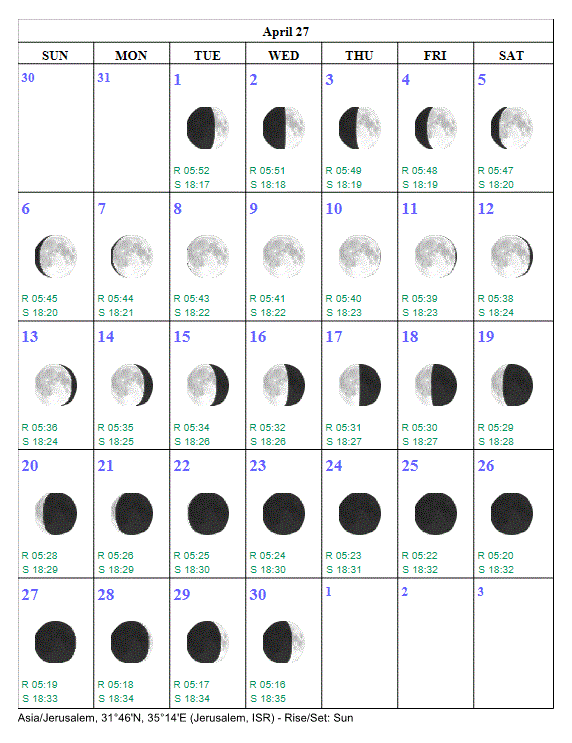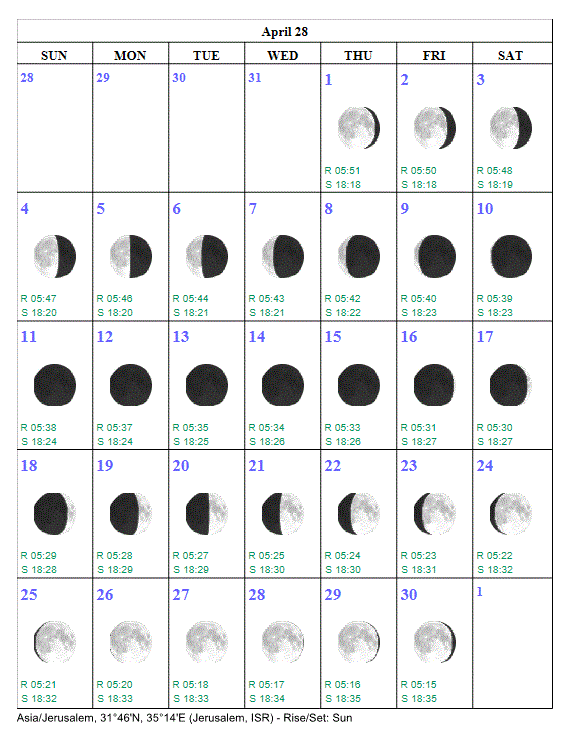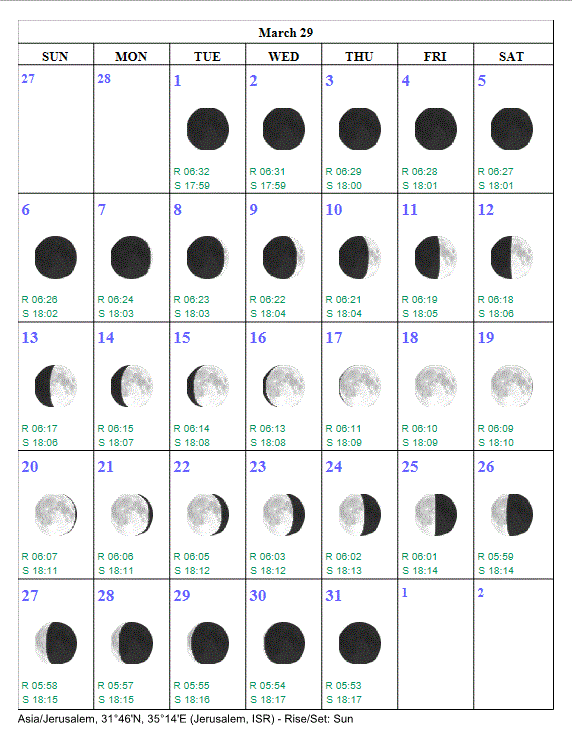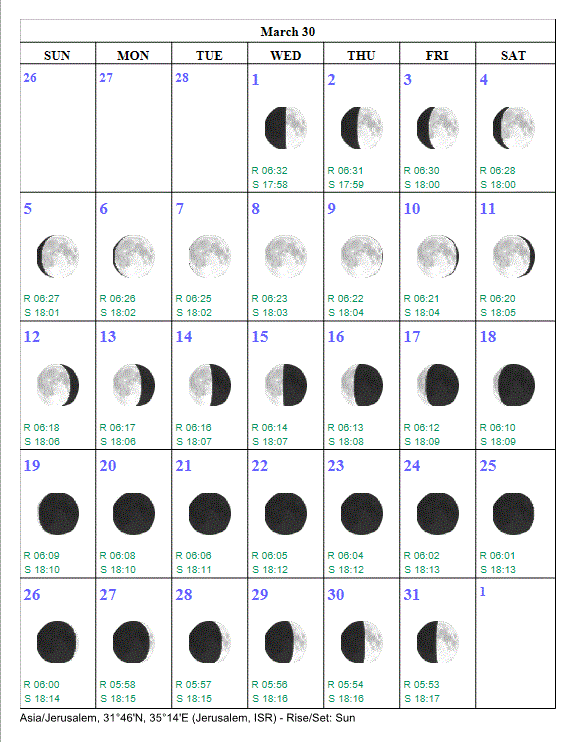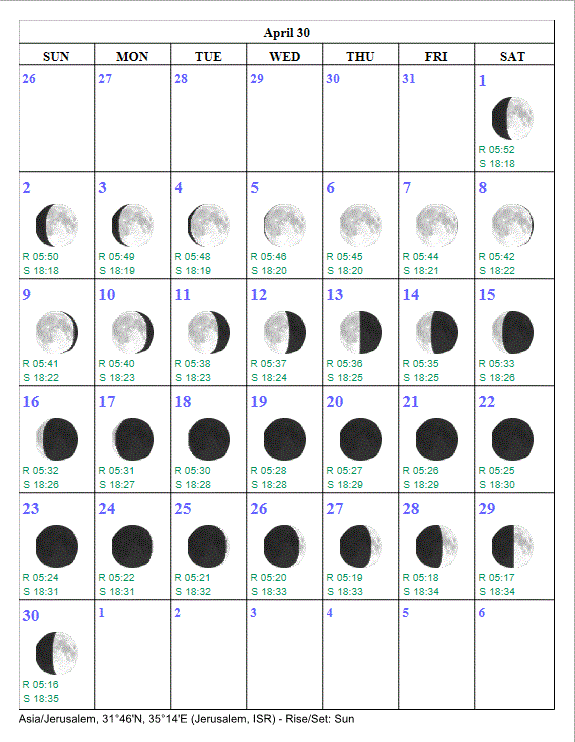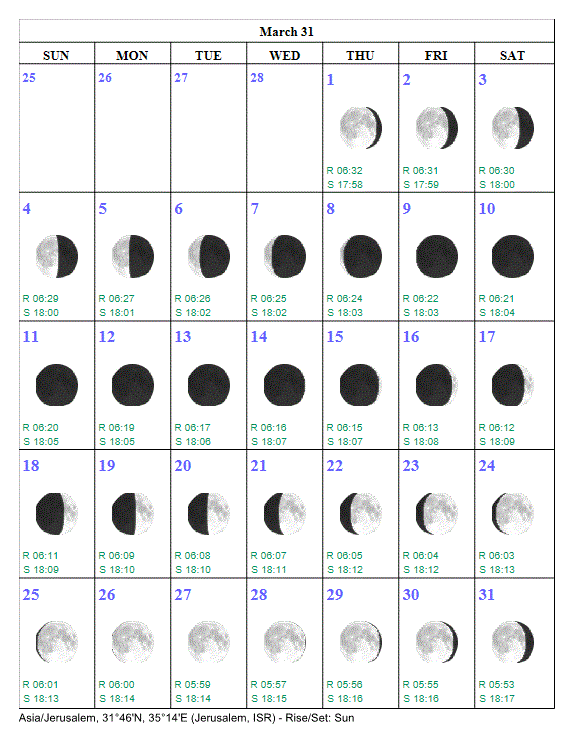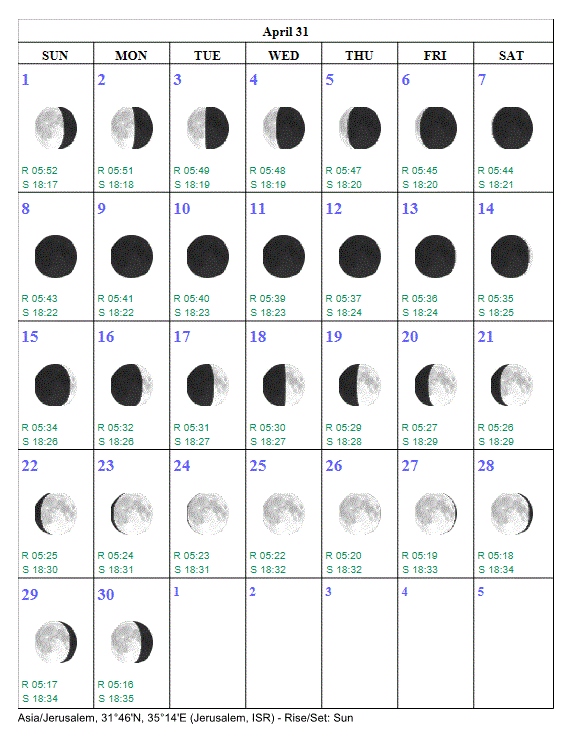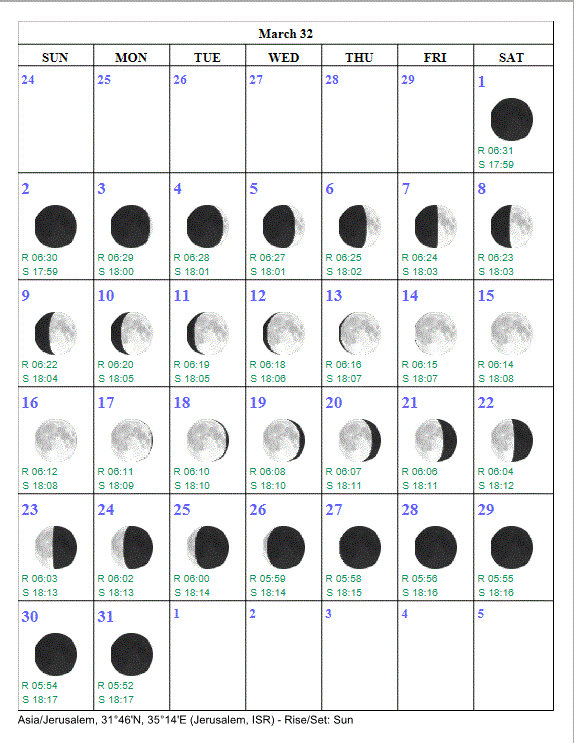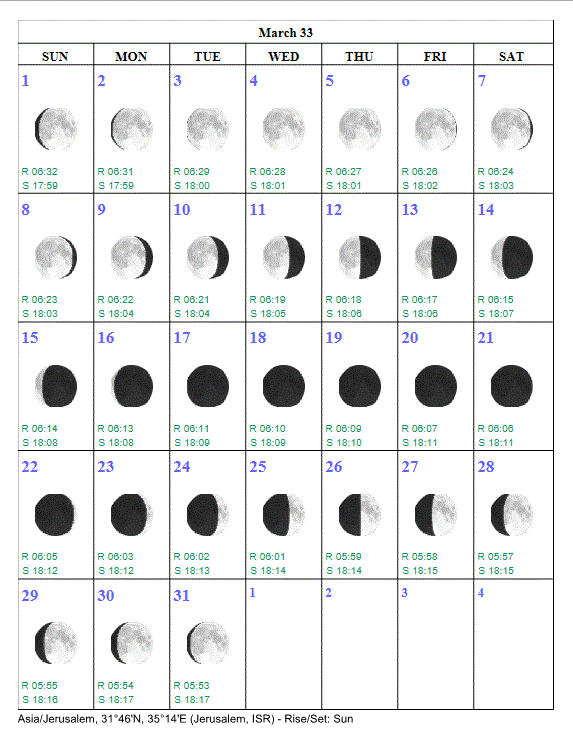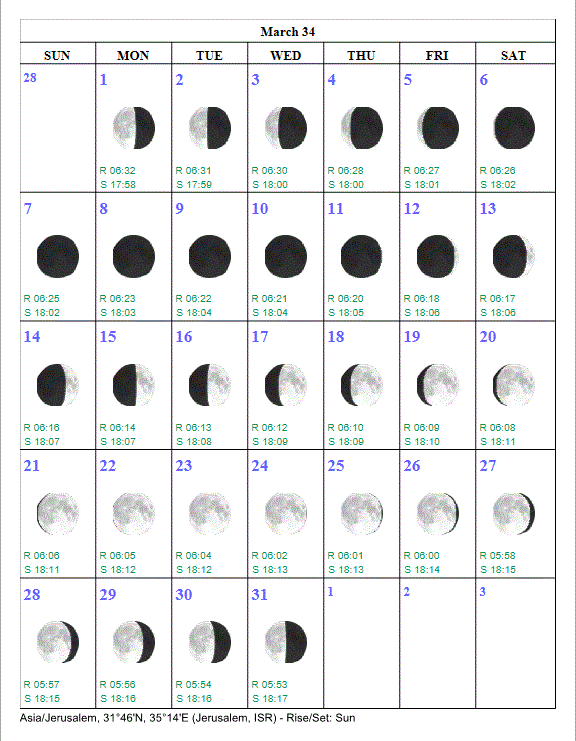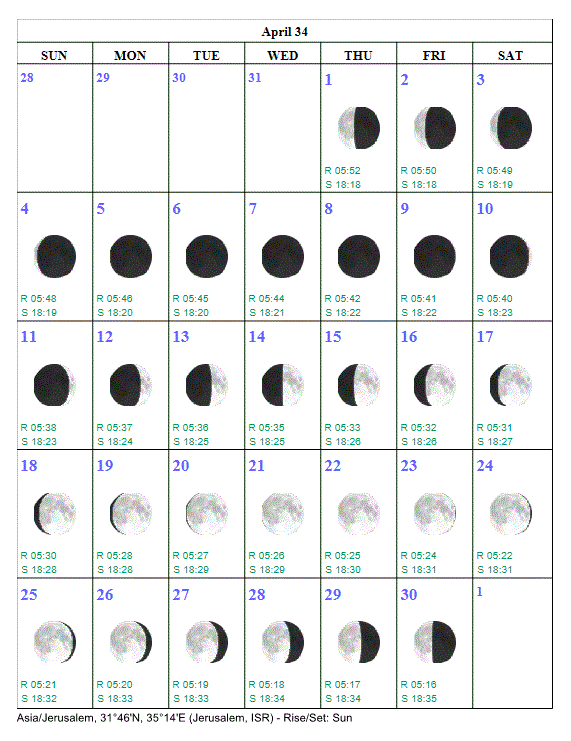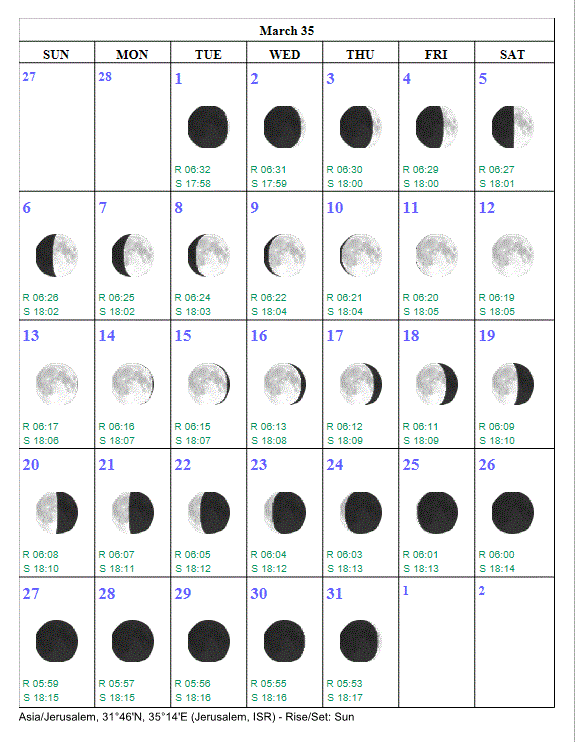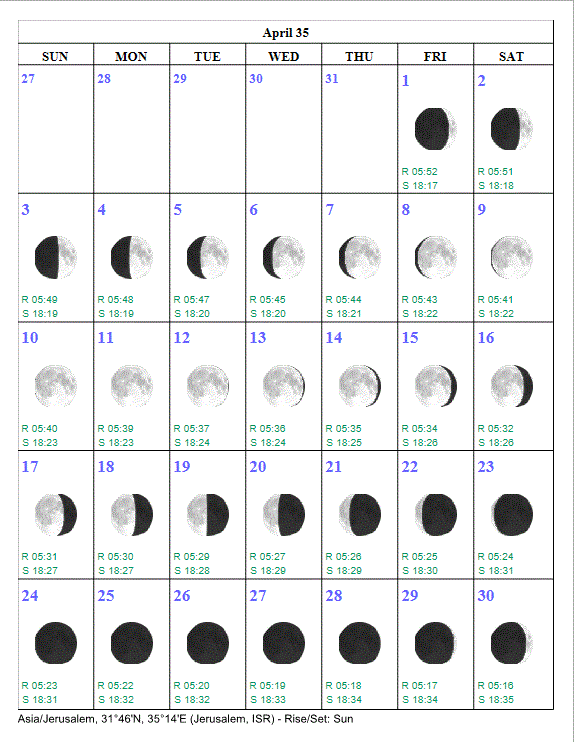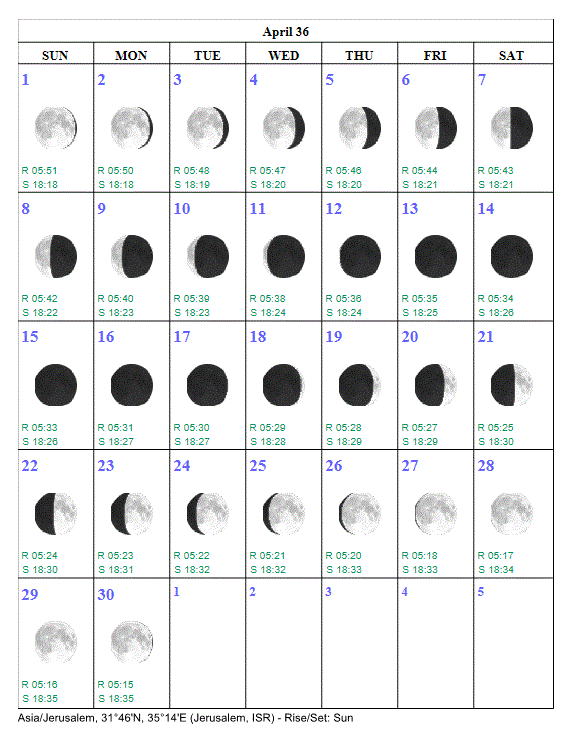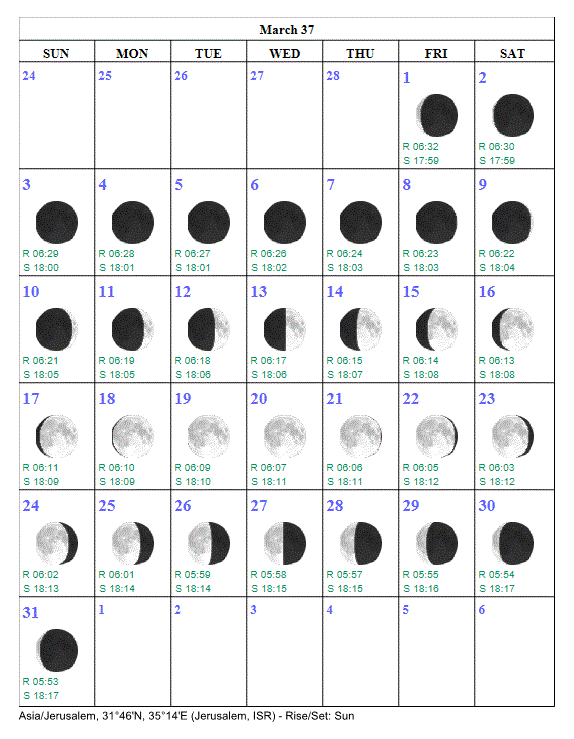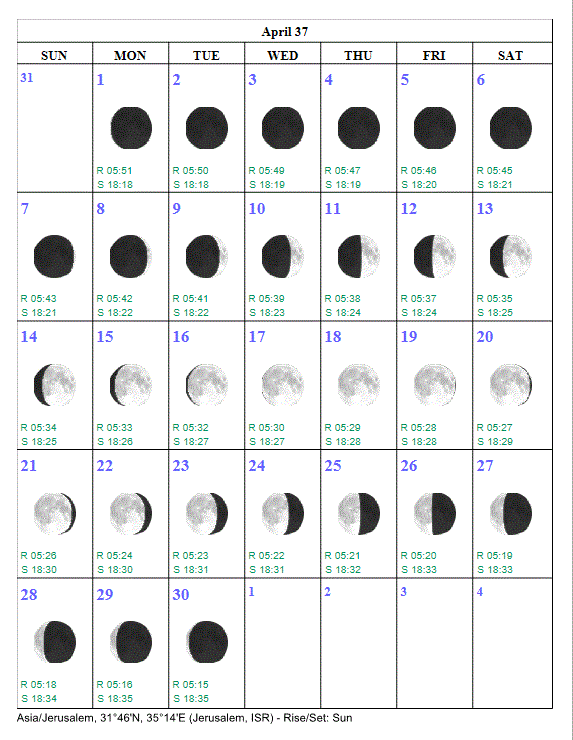Tracking the Day-of-the-Sun

By: A-Quest-for-Creation-Answers
Revised by J. Dwyer on June 9, 2015 (+2)
Copyright © 2003-2021 James D. Dwyer
Email: quest@creation-answers.com
Reference: www.design-of-time.com
You may freely copy or distribute this material.
(Not to be sold).
____________________________________
Introduction
The large focus of the currently presented paper is those families that comprised the priesthood of Israel appear to have tracked a month-like cycle of 30 days for celebratory purposes. It is manifest from certain passages in the Bible (and miscellaneous sources) that Israelite priests were cautious to celebrate and to present sacrificial offerings in association with the renewal of 30 days. Of significance is that the renewal of 30 days was probably officially tracked and celebrated in Judea throughout most of the Temple Era.
Other astronomer-priests who flourished in the ancient Middle East appear to have likewise revered and celebrated a continuous cycle of 30 days. The track of a 30-day cycle can be recited from Assyrian, Persian, and Egyptian sources. Of further significance is that this respective cycle was sometimes time tracked in segments or in units of 10 days.
A plausible reason for why early astronomers did once time track the renewal of 30 days can be deduced from portions of early-written literature attributed to Enoch. Certain passages embedded in the Enoch literature indicate that each passing year cycle has inherent day divisions or time stations. Among the time stations detailed in the astronomical book of Enoch is that of an equally-spaced station or day attributed to the Sun. This respective time station--appearing at the uniform distance of always 30 days--was perceived to be integral in the measurement of the year cycle.
The priestly time track and celebration of the renewal of 30 days raises an ultimate question concerning the chronology of the time station that was attributed to the Sun. It is here pertinent that early Christian records point to a possible chronology for the once celebrated Day-of-the-Sun.
____________________________________
Chapter One
Significance of the 30th Day
Celebration of the 30th day
The renewal of a cycle of 30 days (Hebrew: 'Chodesh') appears to have been regarded as a rather special occasion throughout the ancient Middle East. The celebration of this respective renewal day can ultimately be connected to astronomy--and to the stated station (or day) of the Sun.
In substantiation of an hypothesis that the traditional Israelite priesthood did once track and celebrate each 30th day, passages from period literature show that an offering was routinely performed in association with the "beginnings" of the month or the "renewal" of the month (refer to Numbers 28:11).
In the Temple Era, it appears that the beginning of the month or the renewal of the month (the Chodesh) required the performance of specific liturgy (refer to 2 Chronicles 29:28). During the renewal celebration, the priestly families are indicated to have sounded loud musical instruments (refer to Leviticus 23:24; Numbers 10:10).
Texts throughout the Hebrew Bible consistently use the word 'chodesh' (or 'hodesh') in reference to the once sacrificially celebrated cycle of the new beginnings or a cycle of the renewal. It here seems pertinent to note that the Hebrew word 'chodesh' (or 'hodesh') as it appears in the Hebrew Bible is interpreted by some of the translators to mean the epoch of the new Moon rather than the renewal of a different type of month cycle. The chodesh (or the renewal or the new beginning) is indeed sometimes used in reference to a lunar-month cycle. However, it is of significance that the chodesh is often used in reference to other time cycles as well. For example, YHVH commanded the Israelites to bring a renewal (chadesh) offering on the day which ended a cycle of 7 weeks--refer to Leviticus, Chapter 23. Other clear examples can be recited from the sea scrolls recovered near Qumran. (On some of the scrolls, the use of a chodesh of 30 days and a chodesh of 31 days is sometimes shown. A related example can also be recited from a certain scroll that shows the offering of the new month as being equal to 30 songs--refer to 'The Psalms Scroll'.)
Some early Jewish literature was not written in Hebrew but in Greek. It is here significant that an analysis of the Greek texts shows that the word for Moon (or 'mhn') was likewise used in reference to a month cycle that was different from the literal lunar cycle. As an example, two passages of the book of Revelation show a time span of 1260 days spanned 42 months ('mhnav'). From these texts, it is very apparent that each of the 42 cited months was once understood to be equivalent to a month-like cycle of 30 days. (Note that a month cycle of 30 days is a month cycle different from the lunar month--which completes in 29.5 days).
Variations of the Greek word 'mhn' used in reference to a 30-day cycle can also be recited from the almost contemporary writings of Philo Judaeus as follows:
- "[The month cycle] is derived the number thirty" ('On the Creation', XIX).
- "[When] we say that from morning to evening there are twelve hours, or from new month to the end of the month there are thirty days, we are including in our enumeration both the first hour and the day of the new month." ('On Dreams, That They are God Sent', 2.257).
- "[The count of] thirty... makes up the cycle of the month... " ('Questions and Answers on Genesis').
(English translation of the writings of Philo are based upon the Yonge version).
It then becomes significant that the meaning of the Hebrew word 'chodesh'--as it was used and understood throughout the Temple Era--pertained to both lunar-based cycles and solar-based cycles. Also significant is that the meaning of the Greek word 'mhn'--as it was used and understood in the late 2nd Temple Era--pertained to both lunar-based cycles and solar-based cycles. This distinction in the ancient meaning of the cited Hebrew and Greek words for the month cycle is then essential for coming to ultimately understand that a cycle of 30 days may have been integral for determining when offerings were to be presented upon the Temple Altar.
The possibility that more than one type of new month was celebrated in ancient Israel can be recognized from sacrificial liturgy subscribed to under the Temple system. Based upon sacrificial itineries followed by the Temple priests, it is very manifest that one type of renewal required the offering of 2 bullocks, 1 ram, and 7 lambs. (Another type of renewal required the diverse offering of 1 bullock, 1 ram, and 6 lambs).
The priestly track of a 'perpetual' month cycle (a month that renewed every 30 days) is pointed at in the book of Daniel--where in Chapter 12, a calendar count of "1290 days" is shown. (It is clear that this time span may have once been understood to correspond with an unbroken sequence of 30-day cycles).
Other passages from the book of Daniel have significance in indicating that a perpetual sacrifice was offered upon the Temple Altar. In example, it was prophesied or predicted by the prophet Daniel that the 'perpetual' sacrifice rate would be suspended for the duration of exactly 2300 times:
"... How long shall... the continual burnt-offering, and... the sanctuary... be trodden under foot?... Unto 2300 evenings and mornings; then shall the sanctuary be cleansed." (Daniel 8:14--based upon the ASV).
The respective Daniel prophecy about the ceasing of the perpetual sacrifice (a number of 2300 sacrifices) was noted by Flavius Josephus (c. 1st century) to have corresponded to a time span of exactly 3 years (refer to 'Antiquities of the Jews', Book XII, Chapter 7:6).
The mention by Josephus about the ceasing of the sacrifices seems significant in the regard the rate of the perpetual daily sacrifice (2 lambs) and the additional rate of the perpetual monthly sacrifice (2 bullocks and a ram) appear to inherently total 2300 sacrifices in correspondence with a time span of 3 years.
Note that the number of days in 3 solar years is equal to 1096 days. It follows that if 2 lambs were offered on the Temple Altar daily (refer to Numbers 28) then a total of 2192 lambs would have been offered across a time cycle of 3 years. In addition, if 2 bullocks and 1 ram were offered once per month (12 times each year) then 108 additional sacrifices would have been offered in this respective time span (3 years). A total number of 2300 sacrifices would then have been offered in correspondence with a time cycle of 3 years. (Note that 2192 daily sacrifices plus 108 monthly sacrifices is equal to 2300 total sacrifices).
The noted number of 2300 sacrifices across 3 years of time then points to an original sacrificial (month) schedule that perpetually renewed at a frequency of at least every 30th day.
While the Daniel prophecy (6th century BCE) appears to have originally been understood in the context of a month cycle that renewed at a frequency of no less than every 30th day, it seems pertinent to here note that 1st-century publications attributed to Josephus consistently refer to a calendar of lunar months. In reference to the cited Daniel prophecy, it then may be of significance that a calendar of lunar months can closely approximate the length of 3 solar years. Equivalence to 3 solar years can be achieved with a luni-based calendar through the intercalation of 1 lunar month and 3 more days).
One of the best interpretations concerning the perpetual rate of sacrifice then is that an offering was prepared/presented at the frequency of morning and at evening on a daily basis. An additional offering (2 bullocks and 1 ram) was prepared/presented in association with a month schedule. (Note that the cited 'perpetual' rate of sacrifice--daily and monthly--would have pertained to only a part of the overall sacrifice schedule).
Thus, an uninterupted cycle of 30 days may have been integral in determining when mandated sacrifices were to be presented upon the Temple Altar.
It here seems pertinent to note that the Hebrew word for the literal lunar cycle or the Moon cycle is yerach (not chodesh). Throughout all passages of the Hebrew Bible there is no single instance that substantiates the epoch of the yerach was ever sacrificially celebrated. Conversely, the event of the Chodesh (the renewal) is consistently shown to have been the time for sacrificial celebration. This essentially seems to mean that the cited renewal (Chodesh) when sacrifices were routinely offered was not quite the same renewal as the Moon or yerach.
The additional sacrifice of 1 bullock, 1 ram, and 6 lambs may have been offered upon the Temple Altar in correspondence with the completion of certain lunar months. In example, the count of a specific lunar day and the associated offering of an additional sacrifice on that respective day is described in an 11th century Jewish manuscript known as 'The Code of Maimonides'. According to the author of this manuscript, it was under the Temple system that an additional offering was presented at the end of those lunar months that were "full" and contained a 30th day (an extra day). An assembly was also noted on those additional lunar days--as follows:
"Whenever the court declared a month as full... it was customary [to assemble at]... a place held ready for that purpose, and there a meal was prepared. They went there not in the evening but in the early morning before sunrise, nor did they go to this meal if they were less than ten persons, nor did they take along anything save bread made from grain or pulse, which was all that they ate at this meal. And this is meant wherever reference is made to the religious meal for the intercalation of a month [= the ceremonious celebration of the 30th day of the Moon]." (English translation of the Hebrew source supplied by Solomon Gandz).
Of significance here is this special lunar day was seemingly celebrated right at the molad of the lunar month (and prior to the evening when the new crescent of the Moon was observed).
In summary to the priestly tradition of tracking a month cycle, it is clear from an abundance of early Hebrew literature that the renewal of the month (or months) was ceremoneously acknowledged. The Chodesh, as a time of renewal, or as a time of new beginnings, was probably tracked and recorded in association with time cycles other than (in addition to) the lunar month.
As further shown below, the ancients would inherently have been capable of performing a perfectly accurate meter of the limits of the tropical year by tracking an uninterrupted cycle of 30 days.
Turn of the month
The cited renewal day (Chodesh) that was sacrificially celebrated under the Temple system appears to have minimally been regarded as a day of memorial among 1st-century Hebrews. This respective day--one of 30 days--appears to have likewise been memorialized as a day of renewal among a segment of the Gentiles.
Regard among both Jews and Gentiles for the turn of the 30th day can be recognized from certain sources that herald from in and prior to the 1st century. It seems pertinent to here note that a segment of 1st-century Hebrews (and devout Gentiles alike) are indicated to have routinely participated in Temple liturgy. The considerable degree of veneration held for the Temple system among a wide body of adherents (including Gentiles) is rather clearly mirrored in 12 consecutive chapters of Acts beginning with Chapter 10.
A degree of religious regard for the 30th day is explicit from the writings of the satirist Horace. In his 'Sermones', the lead character of Horace's play is shown to have carried on the following conversation with a certain Fuscus Aristius:
[Lead Character] "... you said that you wanted to tell me something in private." [Fuscus Aristius] "... you will be told on another occasion... for of the Sabbaths this is the 30th day. Would you affront the circumcised Jews?" [Lead Character] "I have no scruple [on that account]." [Fuscus Aristius] "But I have... I will speak with you on another occasion." [Lead Character] "And has This Sun arisen so disastrous upon me!..." [1, 9, 65-70. English translation based largely upon C. Smart (Harper & Brothers, 1863).]
It seems clear from the quoted passage of 'Sermones' that a 1st-century adherent of the Temple system would have then been mindful of the turn of the 30th day. In fact, some contemporary followers of Temple liturgy are shown to have interpreted (at least) a portion, or period, of Sabbath time in association with the renewal of 30 days. (Perhaps the cited day of record, or renewal, was regarded as a minor Sabbath because of the hour, or hours, during which the additional sacrifical ritual was enacted by Temple priests).
The cited passage from 'Sermones' was written rather late in the Temple Era--and only about six decades before the Temple was destroyed by the Romans. The late-Temple time frame in which 'Sermones' was written tends to indicate that the cited day of renewal was tracked and recorded among families that comprised the priesthood--and among adherents of the Temple system--for as long as the 2nd Temple stood.
Regard for a 30-day cycle among Judeans who flourished in the Temple Era can likewise be recognized from portions of 'The Panarion' by Epiphanius of Salamis--as follows:
- "Pharisees . . . paid tithes of the 30th days; and they also gave the firstfruits of the 50th days." (refer to Against Pharisees Section, translation mine).
- "Israel . . . on leaving Egypt was handed down God's Law . . . circumcision and Sabbath keeping, and also tithing . . . the presentation of firstfruits both on the 50th and on the 30th days." (refer to the Judiasm Section, translation mine. For more information refer also to an English translation provided by Frank Williams).
The possibility that early priests did hold to a tradition of tracking the renewal of 30 days--a new beginnings cycle--can also be recognized from the content of writings left by primal or original Christians. The following passage from the book of Revelation can be recited as evidence:
I was given a reed like a measuring rod and was told, "Go and measure the temple of God and the altar, and count the worshipers there. But exclude the outer court; do not measure it, because it has been given to the Gentiles. They will trample on the holy city for 42 months. And I will give power to my two witnesses, and they will prophesy for 1,260 days, clothed in sackcloth..." [11:1-3, English translation based upon the NIV.]
The cited reference to a time span of 42 months across 1260 days is somewhat unusual in comparison with other calendar systems used in the 2nd-Temple Era. For example, writings left by early rabbis focus upon the reckoning of an annual calendar comprised of lunar months.
Even though the quoted reference to a time span of 42 months appears to be unusual in the historical context of the late Temple Era, this same time span (1260 days) is referenced in a subsequent passage of the book of Revelation--as follows:
Then God's temple in heaven was opened... A great and wondrous sign appeared in heaven: a woman clothed with the Sun, with the Moon under her feet and a crown of twelve stars on her head. [11:19-12:1]... The woman fled into the desert... for 1,260 days... (12:6)... The beast was given... to exercise his authority for 42 months. (13:5). [English translation based upon the NIV.]
From these rather unusual references to a 42 month span of time (a time span that undoubtedly traversed 1260 days) it seems very clear that an ongoing 30-day cycle could have at one time been significant in performing Temple liturgy.
Note that a time span that traversed 42 month cycles containing 30 days in each month-like cycle is exactly equal to 1260 days. Further note that a time span of 42 month-like cycles extending across 1260 days indicates that the cited cycle of 30 days was tracked continuously. Essentially, there is no evidence that the indicated priestly track of 30 days was ever broken.
Based upon the cited record of the workings of a Heavenly Temple, it is not illogical to at least suspect that the priestly courses did indeed once track and record an ongoing cycle of 30 days (a cycle of renewal or new beginnings).
This possibility (that the priests would have maintained records of a cycle of 30 days) is in agreement with a lunar-month calendar by which rabbis dated the destruction of the Jerusalem Temple. To be more specific, the Mishnah of Taanith IV. 6 has that the daily sacrifice ceased to be offered on the Temple Altar on the 17th day of Tammuz.
Because the 2nd Temple was destroyed by the Romans in the year 70 CE then the day when the daily "sacrifice ceased" would inherently have coincided with July 14 of that year. (Note that in the year 70 CE, the 17th day of the lunar month of Tammuz in the Jewish Calendar was also the same as the 14th day of the month of July in the Julian Calendar).
Thus, the Mishnah record of a day when the Temple sacrifice ceased points to the span of 1260 days (as is recorded in the book of Revelation) as commencing right on this same day [= on July 14, 70 CE]. The composite historical record is then implicit in showing that the cited 'Times Calendar' (of 30-day months) would have renewed right on this same calendar day [= the 17 day of Tammuz in the year 70 CE, a day when the daily sacrifice ceased].
More information about the ceasing of sacrifices at the Temple is shown in subsequently presented chapters.
It here seems of some related significance that the early Christian movement can closely be connected to one of the chief priestly families--the course of Abiah. This indicated connection to the Temple course of Abiah essentially means that writings left by the earliest of the Christian teachers (including even Jesus) not only mirror the views of certain religiously minded Israelites (those who lived in the 1st century) but these writings surely also reflect opinions and interpretations espoused by certain high-ranking members of Israel's ancient priesthood.
Jesus--through his mother's lineage--appears to have been related (by blood or by marriage) to a ranking family of priests (the Temple course of Abiah). This connection between the original Christian movement and a family of ranking priests seems very apparent from the book of Acts (refer to the initial chapters). The book of Acts further indicates that a "great company of the priests were obedient to the Christian faith" (refer to Chapter 6:7). Of further significance is that one or more of the New Testament authors may themselves have been ranking members of the then priesthood. The possibility that some among the Apostles held this office is manifest from Polycrate's epistle to Victor (2nd century CE). In this epistle it is stated that the Apostle John "was both a witness and a teacher... and being a priest wore the sacerdotal plate" (refer to Eusebius's Church History). John the Baptist--another ranking religious figure of Jesus' time, and apparently a relative of Jesus--is referred to by a number of Christian authors. The priestly John (of the course of Abiah) is shown to have first preached the coming of a Kingdom of God... a message that Jesus also preached.
A regard among early Christians for the renewal of the 30th day (a station or a day of the Sun) can further be recited from certain texts produced prior to the 4th century. Writings produced by some authors who flourished in this era of the Christian Church have detail of a festival celebrated in pace with the Day-of-the-Sun.
The primal Christian celebration of a festival in pace with the Day-of-the-Sun is significant in the regard that adherents of the then popular religion of Mithras appear to also have celebrated a feast on the Day-of-the-Sun.
The track and celebration of the Day-of-the-Sun among both 2nd-century Christians and adherents of Mithras can ultimately be traced to liturgy celebrated among more ancient residents of Middle East. A Middle-Eastern association between the two religions is easy to recognize from Israel's previously cited Temple tradition and also from Persia's reverence for the Sun-god (Mithras).
A religion devoted to the Sun-god (Mithras) became predominate in Persia (after about 1000 BCE). Worship of the god-of-light (Mithras) was eventually assimilated into the Roman Empire--where even some among the Roman emperors became devotees. Roman devotion to the Sun-god Mithras peaked in about the 3rd century CE. However, after this century, Mithraism faded from being a prominent religion (Wikipedia).
It is here significant that Persians well prior to the 1st century can be recited to have carefully tracked the reoccurrence of 30 days--as a never-ending, uninterrupted, unbroken cycle. This means that adherents of the Sun-god (Mithras) would surely have understood/interpreted the Day-of-the-Sun in the context of a cycle of 30 days.
Thus, it seems reasonably clear that--in other regions of the ancient Middle East--the reoccurrence of the Day-of-the-Sun would likewise have been tracked in pace with a cycle of 30 days. (For pertinent information of the early Persian track and celebration of the 30th day, refer to the subsequently presented section).
One of the clearest examples of the Christian celebration of the Day-of-the-Sun--a day also then celebrated in honor of Mithras--can be recited from the following portion of 'The First Apology' by Justin-the-Martyr (c. 115-165):
"[The Christian celebration of the Eucharist is]... imitated in the mysteries of Mithras... And on the day called the Day-of-the-Sun, all who live in cities or in the country gather together to one place... [and] bread and wine and water are brought, and there is a distribution to each... The Day-of-the-Sun is the day on which we all hold our common assembly, because... [Jesus appeared from the grave] on the Day-of-the-Sun... ".
Then, certain passages of text attributed to the earliest among the Christian authors rather clearly mirror that the schedule by which the original Church assembled would have been identical to the sacrificial itinerary followed by the Temple priests. Essentially, the indicated Christian celebration of liturgy in pace with the Day-of-the-Sun would inherently have paced the Day-of-the-Chodesh that was sactioned for memorial under the Temple system.
The above quoted portion from 'The First Apology' was originally written by Justin as an appeal on behalf of Christians to the 2nd-century rulers of Rome. The citation of the religion of Mithras was obviously made by the original Justin to win some degree of approval from the Roman magistrates. It here seems pertinent to note that not all portions of text that appear in current versions of this work appear to have been penned by the original author. The clear possibility that text was added after the time of Justin is manifest from those portions of text that have the flavor of Christianity holding status as an approved state religion. The primal version of 'The First Apology' would surely have shown the common assembly and Eucharist celebrated in pace with the Day-of-the-Sun without the addition of any negative commentary about the religion of Mithras. In addition, it is doubtful that an apparently appended reference to the planetary week was part of the original text.
The Christian celebration of a festival in association with the Day-of-the-Sun [= the Day-of-the-Chodesh] can further be recited from passages of 'The Didache' (a document presumed to have been written by Christians in 1st-century Syria):
"On the Lord's Day of the Lord... Come together. ... Break bread. ... Carry out the Eucharist... "
The commemoration of the Lord's Day [= the Day-of-the-Sun] seems to also be reflected in the following passage from the 1st-century book of Revelation:
"I was in the Spirit on the Lord's day [= the Day-of-the-Sun], and heard behind me a great voice, as of a trumpet" (Chapter 1:10).
It here seems to be significant that the cited Christian memorialization of the Day-of-the-Sun (or the Lord's Day) was attributed to traditions held among segments of the Hebrews from very ancient times. Essentially, original Christians appear to have believed that tracking the Lord's Day (the Day-of-the-Sun) pertained to a set of religious liturgy that was practiced in ancient Israel--even prior to the time of the original Christians.
This Christian understanding of the commemoration of a day of record (the renewal of 30 days) is shown in an epistle written at the 1st part of the 2nd century CE. In his letter to the Magnesians, the Bishop of Antioch (Ignatius) was careful to send the following admonition to the early disciples:
Be not deceived by heretical opinions, nor by ancient fables... the divine prophets lived according to Christ... living in observance of the Lord's day [= the Day-of-the-Sun], on which day also our life rose... even the prophets were disciples... " (Chapter 8-9).
This implies that the Lord's Day [= the Day-of-the-Sun] was understood by early Christians to have been a day that was tracked prior to the time of the Christians. Essentially, the renewal of 30 days (the Day-of-the-Chodesh) appears to have been commemorated among segments of the Hebrews in the earlier era of the prophets.
The indication from early-written Christian literature then clearly is that adherents of the Temple system did probably memorialize the reoccurrence of the Day-of-the-Sun (a day of record). As is further shown below, the track of the Day-of-the-Sun appears to have remained a practiced tradition among segments of the ancient Christians for three centuries (or more).
It here seems pertinent to note the celebration of liturgy in pace with the planetary day Sunday was probably NOT followed among primal Christians. This hypothesis has a considerable amount of merit in the regard that ferial days (festival days) are not generally shown in alignment with the 7 planetary days in Christian writings that were authored from before about the 4th century. Essentially, the earliest among the Christians are not indicated to have been familiar with the modern week cycle. The cited memorialization of the 'Day-of-the-Sun' by the (original) priestly Christians almost surely would have corresponded with the same day of record (the Day-of-the-Chodesh) that was tracked by the traditional priesthood. (The early Christian commemoration of a day of renewal seems to explain more of why in the book of Acts so many of the priests are shown "obedient to the faith"--refer to Chapter 6:7).
The ancient memorialization of the renewal of 30 days can also possibly be detected from what is known about ancient non-traditional and Gnostic Christians. Though, as early as the 2nd century CE, they were considered to be heretical, it seems to be of related significance that the Gnostics paid special heed to the "30 aeons". (They also highly revered "the tricontad").
Passages from certain Christian works--written in and after the 3rd century--can further be recited as evidence that early or original Christians did probably track the Day-of-the-Sun (the Lord's Day) in association with a running cycle of 30 days. In example, a portion of text attributed to the Christian astronomer Anatolius (c. 3rd century) does clearly show that the Eucharist was then celebrated--but only on a specific day:
"... the successors of Peter and Paul, who have taught all the churches in which they sowed the spiritual seeds of the Gospel, that the solemn festival of the resurrection of the Lord can be celebrated only on the Day-of-the-Lord [= the Day-of-the-Sun]...[They] hold that it should not be lawful to celebrate the Lord's mystery of the Passover at any other time but on the Day-of-the-Lord, on which the resurrection of the Lord from death took place, and on which rose" ('The Paschal Canon Of Anatolius', Chapter 10). For more information, refer to:
Christian histories written in and after the 4th century are explicit in showing that--among a segment of the ancient Christians--the Eucharist was not only celebrated in association with a solar-month cycle but the respective cycle was that of 30 days. The commemoration of the Eucharist--celebrated in association with a month-like cycle of 30 days--can be recognized from the following portions of 'The Ecclesiastical History of Sozomen':
The ancient Hebrews... offered the sacrifices after the vernal equinox, when the [Day-of-the-]Sun is in the first sign of the zodiac, called by the Greeks the Ram... and that at old Rome the members of this sect still observe the same practice as the Romans, who have not deviated from their original usage in this particular, the custom having been handed down to them by the holy apostles Peter and Paul... Hence arises my astonishment that those who profess to adopt the Jewish custom in the celebration of this feast, do not conform to the ancient [sacrificial] practice of the Jews... The Montanists, who are called Pepuzites and Phrygians... affirm that it is right to attend exclusively to the cycles of the Sun. They reckon each month to consist of thirty days... For they compute the day of the creation of the Sun, mentioned in Sacred Writ, to have been the fourteenth day of the Moon... They always celebrate... on the day of the resurrection [= on the Day-of-the-Sun]... (Book 7 Chapter XVIII).
It can further be interpreted from the following portion of 'The Ecclesiastical History of Socrates Scholasticus', that the Eucharist may have once been determined through the track of a solar-based month. (This would have been true concerning a segment of ancient Christians).
"In Asia Minor most people kept the fourteenth day of the Moon, disregarding the sabbath [month cycle]: yet they never separated from those who did otherwise... While therefore some in Asia Minor observed the day above-mentioned, others in the East kept that feast on the sabbath indeed... [and differed] as regards the month [cycle]... the latter kept Easter after the equinox... `for,' said they, `it ought to be celebrated when the [Day-of-the-]Sun is in Aries, in the month called Xanthicus by the Antiochians, and April by the Romans.' In this practice, they averred, they conformed not to the modern Jews, who are mistaken in almost everything, but to [the traditions of] the ancients... Thus these people were at issue among themselves. But all other Christians in the Western parts, and as far as the ocean itself, are found to have celebrated Easter... from a very ancient tradition [= the Temple tradition]." (Book 5, Chapter 22).
It is here manifest that primal Christians assembled to commemorate the Eucharist on the following diverse dates:
- The Eucharist was commemorated upon the 14th day of the Moon while the Sabbath of the month (the Sabbath that renewed 30 days) was disregarded.
- Some in the East celebrated the feast on the Sabbath of the month indeed.
Thus, it seems clear from certain historical sources that the reoccurrence of the Sabbath of the 30 days [= the Day-of-the-Sun] was integral for determining when to celebrate the Eucharist--at least among a segment of early Christians.
Of related significance is that some of the early Church Canons show that Christians celebrated the Day-of-the-Lord or the Day-of-the-Sun in addition, or in overplus, to the 7th days. It is then significant that the cited day of record was probably commemorated among early (or original) Christians in overplus to days of Sabbath rest.
The unbroken track of 30 days
In addition to Israelite sources, Assyrian, Persian, and even Roman sources seem to additionally confirm that a running cycle of 30 days was time tracked in the ancient Middle East.
To further illustrate that some among the early astronomers did track a running cycle of 30 days, a calendar shown in the book of Ezekiel can be cited. (This respective calendar appears to have been the same or similar to calendars used in ancient Assyria and in early Persia).
It is here significant that the book of Ezekiel appears to herald from a very ancient source. (This respective book could have been authored by a member of Israel's early priesthood--c. 6th century BCE).
Of particular interest is that the cited priestly source (Ezekiel) contains 13 chronological dates (as tabled below).
------------------------------------ EZEKIEL'S DATES from Hebrew and Septuagint versions ------------------------------------ 1. 5 year 4 set 5th to month 2. 6 year 5 set 5th to month 3. 7 year 5 set 10th to month Alex.15 4. 9 year 10 set 10th to month 5. 11 year [1] to month 6. 10 year 10 set [1] to month 7. 27 year [1] to month first 8. 11 year first set 7 to month 9. 11 year 3 set [1] to month 10. 11 year 12 set [1] to month 11. 12 year first month 15th 12. 12 year 12 set 5th to month 13. 25 year first set 10th to month ------------------------------------ [1] = echad (Hebrew), or mia (Greek) first = rosh (Hebrew), or proton (Greek) month = chodesh (Hebrew), or mhn (Greek)
The cited 13 chronological dates are very significant in the regard that on each of several different occasions the cited priest is indicated to have received communication and special instruction from YHWH. (It is fortunate that on each occasion that Ezekiel came into contact with YHVH, the priest-author was cautious to record the exact date when the communication was received).
Ezekiel's dates seem to be unique in the regard that this author never uses a 'day' descriptor. Instead, relative to the renewal (or 'Chodesh'), a number is all that is used.
Of possible significance is that several of the dates listed by the author of Ezekiel are equivalent to the number 'one'. Essentially, 5 of the 13 cited dates are simply listed as 'one'. (For the 'one' date, the Greek version of Ezekiel uses the word 'mia' and the Hebrew version of Ezekiel uses 'echad'). It ultimately seems strange that the cited 'one' date is listed without a day descriptor in all 5 of the recorded instances. (As is further shown in the subsequently presented chapters, the notation of a singular date--just 'one'--can frequently be recited from early-written Jewish texts). The indicated early use of the calendar term 'one' may mean that priest-astronomers were knowledgeable of the cited system of tracking Sun and Moon stations. In scribing days, it seems probable that the ancients reckoned some of the days (the renewals) to be different from the other days. (The renewals would have been reckoned to stand out and apart from the time stream--as set-apart days).
Especially unique about Ezekiel's 13 dates is that almost all of the numbers (relative to the renewal cycle) are listed to be a multiple of 'five' (a five or a ten). Because many of these queer dates are almost exclusively comprised of multiplies of 'five', it seems possible to conclude that the author of Ezekiel may have possessed knowledge of a '10 count' system.
The Kultepe Calendar (used in ancient Assyria) appears to have been predicated upon a count of 10 days. This count (ten) was repeated across a time grid of 30-day cycles. "For three years, the ten counts ran congruently with the months and the years. Then, after the insertion of a 15-day shapattum period, they [the '10 counts'] overlapped from one month into the next, returning to congruency with the months after the next shapattum... " (Britannica, 1972).
It is clear that the cited Assyrian Calendar was predicated upon an unbroken count of 10 days. This count ('ten') was repeated across a cycle of 6 years (or for 2190 days). Each cycle of 6 years is therefore indicated to have contained 72 month cycles (of 30 days per month) and two shapattum intervals (of 15 days each). The indicated unbroken cycle of 10 days can then be recognized to have been rather essential for tracking the renewal of 30 days across long time spans.
A quite similar method of keeping track of the renewal of 30 days (also in the region of the ancient Middle East) can also be recited from the writings of Biruni (a medieval astrologer/astronomer who lived in Iran).
In 'al-Athar al-baqiya', Biruni reported upon the early Persian reckoning of a year of 360 days--as follows:
"[The old Persians] counted the year to 360 days, and each month to 30 days without a removal, and they inserted one month in each sixth year, and two months into each 120th year... ". (Note that the English translation--as shown--is comparable to Sachau's edition of 'al-Athar al-baqiya', page 11. Further note that the last of the intercalations of a month at the 120th year took place, according to Biruni, in the reign of the Sasanian king Yazdegird I, 399-420 CE--refer to Sachau's edition, pages 33, 45, 118, and 119. For additional verification of this peculiar 120-year count, refer to 'Old Iranian Calendars', by S.H. Taqizadeh.)
It is rather clear (as was reported by Biruni) that ancient Persians did once count an unbroken cycle of always 30 days. According to Biruni's report, early Persians did count this never interrupted cycle in annual segments of 360 days. (This 12-month count of always 30 days was undoubtedly made so as to approximate the limits of the solar year). It was further explained, by Biruni, that the calendar count of 360 days required the periodic intercalation of an additional month (where a supplementary month was intercalated every six years and a supplementary month was also intercalated each 120 years).
The early Persian calendar comprised of 30-day cycles, as was described by Biruni, would inherently have been rather precise (on the average). It appears that this respective calendar could have been continued without the application of any additional calendar rule for upwards of 4 millennia. (Essentially, the described calendar would have been valid for 32 cycles of 120 years). The calendar rules, as stated by Biruni, would thus have achieved 1461 cycles of 30 days in each cycle of 120 years--or a total count of 43830 days in each segment of 120 years. The stated calendar rules would consequently have produced a quite accurate calendar that averaged 365.2500 days per year. It is nevertheless apparent that after a time span of 3840 years or after 32 cycles of 120 years the scheduled intercalation of a supplementary month [30 days] would need to have been skipped or omitted.
The historian Herodotus can also be recited to partially substantiate that early Persians did once track a cycle of 30 days. (Unlike Biruni who wrote of historical events that preceded his time by several centuries, Herodotus--who lived in the 5th century BCE--was alive almost contemporaneously with the historical events he wrote of). In his work entitled 'The Histories', Herodotus wrote that a rate of tribute was routinely paid to the Persian king (Darius). This respective rate happened to be 360 white horses--where a white horse was paid "for each day in the year" (refer to Book III, 90, A.D. Godley edition).
The early adhered to Persian calendar of 360 days can ultimately be traced from a more ancient source (perhaps as far distant as 1000 BCE). From this primal source, it is probable that a calendar count of 360 days (counted in 30-day segments) came to be used throughout the Middle East (and regions farther to the East and West).
Of additional significance is that the indicated track of a 30-day cycle among ancient Persians appears to mirror the cycle of the Sun (a cycle of 30 days) that is described in Enoch's astronomical book. (For pertinent information concerning an equally distant station of the Sun, refer to the subsequently presented Chapter Two).
The cited cycle, or station, or the Sun may have been integral in defining a tithing schedule that was followed among adherants of the Mesopotamian Religion. This can perhaps best be recognized in the Esretu (the standard Babylonian one-tenth) that was presented to the sun-god Shamash (refer to Wikipedia, Tithe).
Thus, based upon the rather clear indication that a station of the Sun (or the 30th day) was once reckoned throughout the ancient Middle East, it can be interpreted that the cited author of the book of Ezekiel held knowledge of a calendar similar or the same as the cited Kultepe Calendar. This means that Ezekiel's unique calendar dates could have been understood in the context of a 30-day time grid.
A time track of 30 days (perhaps also similar to the cited Kultepe Calendar) can seemingly be identified in the previously referred to book of Daniel. In Chapter 12, reference is made to a "time, times, and the dividing of time"--a span of "1290 days". (Note that this time span does inherently correspond with a sequence of month-like cycles of 30 days and shapattum intervals). In addition, reference is made to a span of "1335 days". (This time span can likewise be interfaced to a combination of month-like cycles of 30 days and shapattum intervals). A study of the early use of stick calendars further indicates that some among the ancients were cautious to keep track of the renewal of 30 days. For more explicit information of the early use of stick calendars, refer to the following online publications:
Signs of the zodiac
Of significance to a study of the once reckoned stations of the Sun and Moon and of early-used calendars in the Middle East is that certain medieval documents (Hebrew) do describe the 12 signs of zodiac in cross-reference with 12 lunar months (calendar months).
The zodiac (12 signs) appears on the floors of certain ancient synagogues (c. 200 to 600 CE). Examples of the 12 zodiac signs (with Helios in his Sun chariot surrounded by angels) have been discovered in ancient synagogues at Beth Alpha, Hammath Tiberias, Khirbet Susiya, Yafia, Sepphoris, Beth Shean, Husifa, and Na'aran. All the pavements show a center zodiac panel.
One of the cited floor mosaics shows the zodiac (12 signs) cross-referenced to 12 lunar months (the same as is listed in certain medieval manuscripts).
Jews in even the 1st century appear to have been knowledgeable of the 12 signs of the zodiac--as the following treatise makes clear:
"The studiers of sublime wisdom now say that the zodiac, the greatest of all circles in heaven, is studded with twelve animals (zoµdia), from which it has derived its name. And that the Sun and the Moon are always revolving around it, and go through each of the animals, not indeed with equal rapidity, but in unequal numbers and periods; the one [= the Sun] doing so in thirty days, and the other [= the Moon] in as near as may be a twelfth part of that time... " (Philo Judaeus, 'On Dreams, That They are God Sent', 2.112, translation by Yonge).
Thus, in addition to the medieval sources, a number of 1st-century texts--those written by Flavius Josephus, Philo Judaeus, and the authors of the sea scrolls--can all be recited to confirm that the zodiac circle was once reckoned in Judea (and from very ancient times).
Some of the 1st-century sources see a symbolic connection between liturgical garments worn by the Temple's highest priest and the divided circle of the zodiac:
XXIV. (117) [The garment of the high priest] ... is a copy and representation of the world; and the parts are a representation of the separate parts of the world ... because each of the hemispheres cuts the zodiac in two parts, and in this way comprehends within itself six animals. (124) Then the twelve stones on the breast, which are not like one another in colour, and which are divided into four rows of three stones in each, what else can they be emblems of, except of the circle of the zodiac? For that also is divided into four parts, each consisting of three animals, by which divisions it makes up the seasons of the year, spring, summer, autumn, and winter, distinguishing the four changes, the two solstices, and the two equinoxes, each of which has its limit of three signs of this zodiac, by the revolutions of the Sun, according to that unchangeable, and most lasting, and really divine ratio which exists in numbers; (125) on which account they attached it to that which is with great propriety called the logeum. For all the changes of the year and the seasons are arranged by well-defined, and stated, and firm reason ... " (Philo Judaeus, 'On the Life of Moses, Part 2', translation by Yonge).
Literature produced in the Temple Era then shows that even the Temple priests possessed knowledge of the signs of the zodiac.
XVI. (80) Now these are the laws which relate to the priests ... on his chest there are twelve precious stones of different colours, arranged in four rows of three stones in each row, being fashioned so as an emblem of the zodiac. For the zodiac also consists of twelve animals, and so divides the four seasons of the year, allotting three animals to each season. (88) And the whole place is very correctly called the logeum (logeion), since every thing in heaven has been created and arranged in accordance with right reason (logois) and proportion; for there is absolutely nothing there which is devoid of reason... And what else could exhibit to us the days and the nights, and the months and the years, and in short the divisions of time, but the harmonious and inconceivable revolutions of the Sun, and Moon, and other stars? (91) And what could exhibit the true nature of number, except those same bodies just mentioned in accordance with the observation of the combination of the parts of time?" (Philo Judaeus, 'The Special Laws, Part I', Yonge translation).
Significance of the Day-of-the-Sun
In summary to the ancient time track of 30-days, it seems clear from early-written literature that primal priest-astronomers were knowledgeable of a station (or day) of the Sun. The reoccurrence of the Day-of-the-Sun appears to have been significantly celebrated by primal priests in the region of the Middle East.
On the basis of the available texts, the following summary points seem to be warranted:
- A running cycle of 30 days appears to have been rather widely revered and celebrated throughout the ancient Middle East. Assyrian, Persian, and even Roman sources are explicit in indicating that a running cycle of 30 days (an unbroken cycle) was carefully time tracked.
- The renewal of a cycle of 30 days appears to have been tracked and celebrated in ancient Israel. This possibility is manifest from those passages of the Bible that provide detail of liturgy celebrated by the Temple priests. The priests can be recited to have celebrated and presented sacrificial offerings on a particular renewal day (Chodesh). Furthermore, the books of the Pentateuch, Ezekiel, Daniel, and Revelation all have calendar counts indicating that primal priests were knowledgeable of a running cycle of 30 days.
- The renewal of a running cycle of 30 days appears to have been revered and celebrated among early Christians. The celebration of the Day-of-the-Sun (the renewal of 30 days) among primal Christians can be confirmed from certain passages of the New Testament and from other early-written Christian sources. On the basis of Christian literature, it is possible to interpret that the renewal of a running cycle of 30 days was likewise tracked and was celebrated by the priesthood--even late in 2nd-Temple Era. It is here of significance that some of the liturgy celebrated by early Christians appears to be synonymous with liturgy that was celebrated under the Temple system.
What is remarkable concerning the ancient track of a cycle of 30 days is that this same time track can be used--even in this modern era--to effectively measure and meter out the rate of the solar year. (In association with tracking a station of the Sun and a station of the Moon, it becomes a correct axiom that the "years are changed with correct precision").
____________________________________
Chapter Two
Why the 30th Day was Time Tracked
Why 30 days?
A collection of writings attributed to an ancient biblical patriarch named Enoch is devoted to astronomy, prophecy, and other topics. Some passages from the astronomical book are significant in showing that a time track of 30 days was once performed by early priest-astronomers. In fact, the astronomical book seems to indicate exactly why a cycle of 30 days was once continuously time tracked.
The Enoch texts are additionally significant in showing that axioms and formulas were once used to track the orbital movements. (Even in the modern era, some of the adages pertaining to astronomy prove accurate enough to be useful for predicting both lunar and solar cycles).
A plausible reason for why each 30th day was once time tracked can be interpreted from nothing more than the various numbers and the descriptions embedded in the Enoch texts. Essentially, the adages and axioms stated in Enoch's astronomical book make it clear that early priest-astronomers would have tracked a "time station" at the distance of each 30th day... and this for the purposes of measuring and metering out both the lunar and solar periods.
As is further shown below, Enoch's notation of keeping track of time stations indicates a method for effectively (even perfectly!) determining the orbital returns.
Validity of the astronomical book
The track of a 30-day cycle among certain early astronomers can be deduced from portions of the Enoch literature--as follows:
"[Chapter 71] The book of the revolutions of the luminaries of heaven... [Chapter 73:]... I beheld their stations... according to the fixed order of the months the Sun rises and sets... thirty days belonging to the Sun... to the Sun and stars... thirty days belonging to them... " ('The Ethiopian Enoch', by Laurence)
It seems clear from passages of text embedded in the astronomical book that the primal author (or authors) attributed some certain significance to a track of "time stations". One of these respective time stations appears to have been tracked or mapped in reference to the Sun at the frequency of "30 days".
In modern terms, Enoch's interpretation about the reoccurrence of a specific day or time station could be stated as an axiom or time formula--as follows:
The revolutions of the heavenly luminaries define a station or day that pertains to the Sun and stars. This celestial station or day reoccurs in a cycle of 30 days (an endless rate).
It here seems pertinent to note that the rate of 1 day in 30 days is inherently equal to 3.33333 percent of the time stream.
Enoch's astronomical book is additionally clear in showing that a "station to the Moon" was understood among a segment of the early astronomers--as follows:
[Chapter 73:] "The year [count] then becomes truly complete according to the station of the Moon, and the station of the Sun... which rise and set in them for thirty days... " (ibid)
The author (or authors) of Enoch thus appears to have interpreted the "revolutions of the heavenly luminaries" in the context of at least the following two time stations:
- A day or station of the Sun each 30th day (3.33333 percent of all time).
- A day or station of the Moon (an unspecified percent of time).
Somewhat puzzling about the content of Enoch's astronomical book (as in other early Hebrew writings) is that a number of passages do show that early astronomers once interpreted the cycle of the year not only in association with "time stations" but in association with a fixed number count. Essentially, each passing year was measured and metered out using a same (or identical) number count of days or time stations (364 stations). The indicated fixed count of days (the same number of annual stations) was applied to each and every annual cycle.
Note that the length of the tropical year inherently spans 365.24 days. Consequently, the turn of the tropical year CANNOT be paced by a fixed, whole-day rate. Because the circle of the year turns in association with a fractional (or partial) day then an effective annual calendar MUST include a leap-day rate. In essence, a calendar-of-days can only keep pace with the turn of the tropical year by periodically skipping the count of a day (or days).
The reason that an identical number of annual days or stations is shown in Enoch's astronomical book (and in other early-written texts) does probably have an answer connected with tracking time stations. Essentially, some among the ancient astronomers would likely have accounted for the cited celestial time stations (those of the Sun and Moon) apart from the days that were numbered as annual days.
The occurrence of the stated day or station of the Sun (each 30th day) can rather clearly be understood from the content of Chapter 73; as cited. What is then missing from the presumed annual count is a clear definition for the occurrence of the stated day or station of the Moon (an unspecified freqency).
It is here of significance that the Enoch literature appears to describe the station or day of the Moon in correspondence with the quarter phases of the Moon. Essentially, certain portions of Enoch's astronomical book show the appearing of the cited station or day of the Moon with a cycle of the lunar quarters.
Note that the Moon travels through four distinct quarter phases in each cycle of it orbit. The four distinctly defined phases are: 1. New phase (when the Moon is fully dark); 2. First-quarter phase (when the Moon is half dark and half light); 3. Full phase (when the Moon is full of light); and 4. Last-quarter phase (when the Moon is half light and half dark). Each of the cited quarter phases of the Moon can be predicted to elapse in a time-span that is approximately equivalent to seven and one-third days.

This appearing of a station or day of the Moon in correspondence with a cycle of the lunar-quarter phases is easy to interpret from the following portions of the cited astronomical book: "(Chapter 72: verse 3)... [the Moon's] light is a seventh portion from the light of the Sun.... (verse 6) Half of it is in extent seven portions... its light is by sevens... (verse 8-10) On that night, when it commences its period... it is dark in its fourteen portions... During the remainder of its period its light increases to fourteen portions [or the Moon's light increases to fourteen portions]... (Chapter 73: verse 4) In each of its two seven portions it completes all its light [or the Moon reaches the phase of full illumination in two seven portions]... " (refer to 'The Ethiopian Enoch', by Laurence).
A more specific definition for the Moon's time station can ultimately be deduced on the basis of astronomy. An almost given conclusion--based upon the modern spin and orbital rates--is that the cited day or station of the Moon would have been a day that was tracked at the frequency of 7 lunar weeks (as is further shown below).
Because each lunar quarter (or lunar week) inherently reoccurs in association with a time span equal to 7.38265 days (on average) then the rate of 1 day in each span of 7 lunar weeks can be recognized to equal 1.93503 percent of the time stream.
For pertinent information concerning the early track of 7 lunar weeks, refer to the following online publication:
Then, to be completely specific about the feasibility of "day counting" the tropical year, the annual circle CAN BE correlated to a specific (or fixed) count of days by separately recording those days that correspond with time stations (those of the Sun and Moon).
Note that the rate of one day in each month-like cycle of 30 days is inherently equal to 3.33333 percent of the time stream and the rate of one day in each cycle of 7 lunar weeks is inherently equal to 1.93503 percent of all time. These two rates of separately counted days--in combination--are equal to 5.26836 percent of the passage of all of time.
Because each passing year cycle is equal to 365.24219 days it is possible to assign 19.24232 of these days (on the average) to the stated reoccurrences of Sun and Moon stations. Thus, if 5.26836 percent of the tropical year (or 19.24232 days per year) are separately accounted for as time stations then the remainder of the year cycle can effectively be represented by a "day count" that does never vary from 346 days.
Remarkable about separately accounting for Sun and Moon stations (a rate equal to 5.26836 percent of the year) is that the residual 94.73164 percent of the tropical year comes to within 11 seconds of being perfectly equal to a whole number of days (346 days)! This then means that through a separated accounting of Sun and Moon stations, the circuit of the tropical year CAN ALWAYS be measured and metered out in the context of a fixed count of 346 days or stations (not 364 stations).
It then seems clear that certain among the axioms and time formulas embedded in Enoch's astronomical book could be predicated upon explicit knowledge of the lunar and solar returns. The solar circle (365.24219 days) inherently does contain a station or day of the Sun (one in a 30-day cycle) and also a station or day of the Moon (one in a cycle of 7 lunar weeks).
346.00000 days (= World stations) plus 19.24232 days (Sun + Moon stations) -------------- equals 365.24232 days (= Tropical Year)
Thus, it seems significant to a study of Enoch's astronomical book that--the length of each passing year is inherently equal to a sum of 346 world stations (which sum is exclusive of Sun and Moon stations).
The sum of 346 world stations (as exclusively counted days) inherently paces a time span that is exactly equivalent to the length of the annual circle or year (in average time). Essentially, 346 days--when counted in association with 19.24232 additional days per year--is equal to 365.24232 days. Thus, the annual result of separately recording the reoccurrence of each station (or day) of the Sun and each station (or day) of the Moon is a time span that is exactly equal to the length of the annual circle or solar year (on the average). The average annual result of tracking 346 days in correspondence with stations of the Sun and Moon is perfect to within an annual difference of only 11.2 seconds (as cited). Remarkable is that the annual result of tracking stations of the Sun and Moon can be recognized as fully or absolutely perfect relative to the rate of the solar year only several centuries before. For more specific information, refer to the online publication entitled:
Enoch's fixed count of the tropical year
While some areas of text attributed to Enoch can clearly be recognized in the context of a correct lunisolar model, a number of passages appear to pertain to definitions of the spin and orbital phenomena that are incorrect.
The most logical conclusion for the disparate information is that a more original version of the astronomical book was in circulation among the ancients. The primal version of the astronomical book appears to have subsequently been modified--or possibly recompiled with other information--by intervening scribes. Essentially, those inconsistent areas of text now attributed to Enoch do probably reflect the action of scribal error (or addition).
One possibly incorrect definition appearing in current copies of the astronomical book concerns the fixed assignment of 364 stations for the length of the year. In consideration that the length of the year exceeds 365 days... and that a rate of "time stations" was within the knowledge of the primal author (or authors)... it is a clear possibility that the original version would have shown 346 stations (not 364 stations) for the fixed annual number.
Based upon the explicit notation that the rate of the tropical year can exactly be measured and metered out through a combinational time track of a station (or day) of the Sun and a station (or day) of the Moon, current copies of Enoch's astronomical book seem to warrant the substituting of the originally written number of annual stations (346) for the wrongly copied number of annual stations (364). Consequently, a closer representation of the outline of the original version of Enoch's astronomical book is probably reflected in the following paragraph:
[Chapter 71:] "The book of the revolutions of the luminaries of heaven, according to... their respective periods... and their respective months... according to every year of the world for ever... ." [Skipping to Chapter 73:] "... I beheld their stations... According to the fixed order of the months the Sun rises and sets... one station or day in 30 days belongs to the Sun... All the remaining days belong to the year... It is the station (or day) of the Moon that brings on all the years exactly so that an annual count of 346 days can be assigned. This count does come neither too forwards nor too backwards by a single day. Through a separated accounting of Sun and Moon stations, the years are changed with correct precision."
Regardless of which recreation of Chapter 73 is believed to more closely reflect the more original version, there is hardly any doubt but that primal priest-astronomers were knowledgeable of a station (or day) of the Sun and a station (or day) of the Moon. It seems remarkable that the Sun and Moon stations shown in early-written Enoch texts can be used to effectively (perfectly) measure and meter out the solar circuit. Even more remarkable is that these same stations can also be used to effectively (perfectly) measure and meter out the period of the Moon.
It here seems significant that the solar circuit can effectively (perfectly) be represented in terms of a number of Sun and Moon stations plus a metered count of 346 additional days. Also by numbering the very SAME stations of the Sun and Moon, the lunar period can effectively (perfectly) be represented in terms of a metered count of 28 additional days. For more information, reter to:
This all means that certain of the axioms and formulas contained in portions of Enoch's astronomical book (the presumed more original version) appear to be remarkably valid. It is very clear that a nearly perfect definition of the solar year--or 365.24232 days in average time--can be achieved by accounting for the lunar and solar stations detailed in the cited astronomical book.
Additionally significant is that in this modern era, a simple count of months and lunar weeks can be used to define the limits of the solar year to within a difference of only 11.2 seconds too slow; however, due to the slowing spin of the Earth, astronomers who were alive at about 3000 years ago should have been able to define the solar year to within the limits of absolute or even perfect accuracy.
Writings attributed to Enoch
Certain ancient sources reflect that the astronomical book of Enoch was read and was studied from a very early time.
Enoch's prowess in tracking lunisolar cycles can especially be recognized from 'The Book of Jubilees'. This Hebrew document--produced in the era of the Temple--relates that the antediluvian patriarch Enoch reckoned jubilee weeks [= a cycle of lunar weeks]. In association with the reckoning of jubilee weeks, Enoch is recited to have 'set in order the months' [= a cycle of 30-days].
"[Enoch] recounted the weeks of the jubilees, and ... set in order the months and recounted the Sabbaths of the years... " ('The Book of Jubilees', Chapter 4:18, Translation by R.H. Charles).
The calendar outlined in the Bible book of Genesis (Chapters 7 and 8) appears to have been predicated upon certain of the cited axioms and time-formulas that are reflected in the primal version of Enoch's astronomical book. For example, the use of a 30-day month between the second month and the seventh month is implied. The simultaneous reckoning of a 150-day cycle is also implied. The double notation of this respective time-span (150 days... perhaps 3 pentecontad cycles) could mean that early astronomers were reckoning both solar and lunar cycles.
For more complete information about antediluvian time cycles, refer to the following online publications:
A book attributed to Enoch was studied and was revered--even as late as the 1st century. For example, one of the books of the New Testament--the book of Jude--contains certain quoted passages from the book of Enoch.
For some reason, the Enoch texts were not copied by mainstream Jewish or Christian scribes. Consequently, most writings attributed to Enoch were lost prior to the renaissance. It is most fortunate that the book of Enoch was copied and consequently was preserved throughout intervening centuries by scribes among Ethiopian Christians and Falasha Jews. The Ethiopian version of this ancient manuscript was eventually translated by modern scholars, and this version of the Enoch texts is now read and studied--along with other recovered versions of the lost work.
It is clear that the recovered versions of Enoch's astronomical book are not exactly representative of the original work or version. Even so, there is hardly any doubt from what has been recovered but that the initial author of Enoch was knowledgeable of an accurate set of axioms and time-formulas. Remarkable is that--through modern knowledge and computation means--some of the axioms recited by the original author of Enoch can be proven to be entirely valid. To borrow words from this very ancient astronomer: "The year then becomes truly complete according to the station of the Moon, and the station of the Sun... ".
____________________________________
Chapter Three
30th-Day Chronology
Jesus' Resurrection
Writings produced by primal Christian authors have that Jesus rose from the tomb early on Sun's Day (the Day-of-the-Sun). Of significance here is that Christian authors of the 1st century would inherently have been contemporary with the priesthood of the late 2nd Temple. As such, a modern reader should probably interpret those earliest references to Sun's Day, not within the context of a 7-day week, but within the context of a month cycle of 30 days. If this respective hypothesis is correct then it becomes hugely significant that the resurrection of Jesus should be dated in line with the Day-of-the-Sun [= the renewal of a month cycle of 30 days].
An answer to finding the day when Christ rose (as a 30th day) would seem rather easy to arrive at. After all, this respective day would inherently align with an unbroken cycle of always 30 days (as previously has been shown). This then means that if a day in the Julian Calendar can be determined for any one recorded instance of a 30th day then a chronology becomes manifested.
The Bible actually does table a chronology for the renewal of a 30-day month (as counted from the epoch of the creation down to the Deluge). This respective calendar record probably stems from writings produced, and reproduced, by priests who flourished as far distant as the 1st Temple. Unfortunately, the 30-day record (as apparently was understood from a day of origin by primal Israelite priests) cannot be linked up with the era of the 2nd Temple, even though the renewal of this respective 30-day cycle appears to have been subsequently celebrated among members of the priesthood and ultimately by the early Christians. For more information about the pre-flood record, follow the previously furnished links.
If there is a solution to coming up with a date for the primal 30th day then it has to be found further along the time line.
Of possible significance here is that Bible prophecy in the books of Daniel and Revelation foretold that sacrifices would cease to be offered on the Temple Altar [= right at the revolution of a 30-day cycle]. The prophetic record about the turn of a 30-day month has possible significance in the regard that the historical record actually does show the Temple sacrifice ceased to be offered on July 14, 70 AD [= Julian day 1746820].
Historical sources describe the destruction of the 2nd Temple by the Romans in the year 70 CE. The Mishnah of Taanith IV. 6 does furthermore indicate that the sacrifice ceased right on the 17th day of Tammuz. Thus, because the 2nd Temple was destroyed by the Romans in the year 70 CE then the day when the daily "sacrifice ceased" would inherently have coincided with July 14 of that year. (Note that in the year 70 CE, the 17th day of the lunar month of Tammuz in the Jewish Calendar was also the same as the 14th day of the month of July in the Julian Calendar).
The record of prophecy--when blended with the record of history--then tends to indicate the renewal of a 30-day cycle on July 14, 70 CE [= the day when the Temple sacrifice ceased].
Of special interest about the day when the Temple sacrifice ceased is that historical sources furthermore indicate the 1st Temple was destroyed in the year 587 BCE. Remarkable here is that the biblical 'Times Calendar' (of 30-day months) can be recognized to have renewed in proximity to this same lunar-month day [= the 17 day of Tammuz] in both years [= in 587 BCE and again in 70 CE].
--------------------------------------- TEMPLE SACRIFICES CEASED ON A 30TH DAY --------------------------------------- Temple Date Date Julian Ceased Ceased Day (Hebrew) (Julian) Number ---- ----------- -------------- ------- 2nd 17th Tammuz July 14, 70 AD 1746820 1st 17th Tammuz July 8, 587 BC 1507210 ---------------------------------------- Number of days in between: 239610 Number of 30-day months in between: 7987
The rabbis teach that--while the daily sacrifice ceased on the 17th day of Tammuz--it wasn't until 20 days later, on the 9th day of Av, that the Temples were burned. Thus, both Temples are indicated to have been burned in the lunar month that came after Tammuz. Of further significance here is that the span of time that elapsed between the burning of the 1st Temple [= July 28, 587 BCE] and the burning of the 2nd Temple [= August 3, 70 AD] can likewise be represented by a whole number of 30-day cycles [= 7987 cycles].
So, how might the indicated chronology between the ceasing of Temple sacrifices [= on the renewal of 30th days] line up with records pertaining to the resurrection of Jesus [= resurrected on the Day-of-the-Sun]?
To more fully illustrate how the stated Temple chronology of 30 days might correspond to the Christian record of the resurrection, the following table is presented. Listed in the table are all occurrences of the 30th days during the months of March and April and for all of the years between 26 CE and 37 CE (refer also to the subsequently presented Appendix). This respective range of months and years inherently encompasses every possible passover date for every year during which Pontius Pilate ruled Judea. (Note the New Testament record shows that Jesus was put to death at the time of the Jewish Passover by the Roman Prefect Pilate.
-------------------------------------------------- CHRONOLOGY OF 30TH DAYS * oriented to the day when Temple sacrifices ceased -------------------------------------------------- 30th Day Julian Full Moon Distance Day # Date From Full Moon ------------ ------- -------------- --------- 1. March 7, 26 1730620 March 21, 26 - 14 Days 2. April 6, 26 1730650 April 20, 26 - 14 Days 3. March 2, 27 1730980 March 11, 27 - 9 Days 4. April 1, 27 1731010 April 9, 27 - 8 Days 5. March 26, 28 1731370 March 29, 28 - 3 Days 6. April 25, 28 1731400 April 27, 28 - 2 Days 7. March 21, 29 1731730 March 18, 29 + 3 Days 8. April 20, 29 1731760 April 17, 29 + 3 Days 9. March 16, 30 1732090 March 8, 30 + 8 Days 10. April 15, 30 1732120 April 6, 30 + 9 Days 11. March 11, 31 1732450 Feb. 26, 31 + 13 Days 12. April 10, 31 1732480 March 27, 31 + 14 Days 13. March 5, 32 1732810 March 15, 32 - 10 Days 14. April 4, 32 1732840 April 14, 32 - 10 Days 15. March 30, 33 1733200 April 3, 33 - 4 Days 16. April 29, 33 1733230 May 3, 33 - 4 Days 17. March 25, 34 1733560 March 23, 34 + 2 Days 18. April 24, 34 1733590 April 22, 34 + 2 Days 19. March 20, 35 1733920 March 12, 35 + 8 Days 20. April 19, 35 1733950 April 11, 35 + 8 Days 21. March 14, 36 1734280 March 1, 36 + 13 Days 22. April 13, 36 1734310 March 30, 36 + 14 Days 23. March 9, 37 1734640 March 20, 37 - 11 Days 24. April 8, 37 1734670 April 18, 37 - 10 Days -------------------------------------------------- * -- The above list of 30th days is exactly inline with the day when Temple sacrifices ceased [= July 14, 70 AD].
A wide range of possible dates for the resurrection is listed above so as to include all possible days when the Passover might have been celebrated in those years when Pilate was Prefect of Judea.
Note that according to early records pertaining to the Jews at Sardica, the Passover was celebrated in March . . . and oftentimes it was celebrated prior to the spring equinox. In example, tables that herold from before the middle of the 4th century show that the Passover was celebrated before the equinox on the following days: March 2, 5, 8, 10, 11, 16, 18, 19, and 21 (For more info, refer to Sardica Paschal Table in Wikipedia).
In addition to covering the month of March, the list also encompasses the month of April (so as to include the range of dates when early Christians are known to have celebrated Holy Week).
Certain, if not most, Christian authors who flourished before the 9th century noted that Christ rose on March 25. Among these were Alexander of Jerusalem (3rd century), Julius Africanus (3rd century), Bede (8th century), and others. Some writers such as Tertullian and Hippolytus (3rd century), Epiphanius of Salamis (4th century), Orosius (5th century), and Dionysius Exiguus, as well as other medieval orators/authors, reflect that Christ was killed on March 25 (and that He rose after 3 days).
As far as the year in which the resurrection of Jesus occurred, Julius Africanus published the 2nd year of Olympiad 202 [= 31 CE]. Hippolytus of Rome, as well Epiphanius of Salamis, noted that Christ suffered in the 18th year of Tiberius [= 32 or 33 CE]. A 3rd century document known as Acts of Pilate relates that the crucifixion occurred in the 4th year of the 202nd Olympiad [= 33 CE], and other Alexandrian writers (such as Annianus) also have AM 5534 [= 33 CE].
In reference to possible historical matches with instances of 30th days (as are listed in the table above) it is of interest that an instance of the Day-of-the-Sun can be recognized in coincidence with March 25 (refer to line 17 which shows the year 34 CE). The indicated occurrence of a 30th day on this date does then match up with records published by 3rd century Christians [= records showing Christ's resurrection on March 25].
The New Testament authors are all in close agreement in showing that Jesus was crucified on the eve of the Jewish Passover [= a day that was probably celebrated at or near the time of the full phase of the Moon]. Furthermore, the writers of the NT all seem to agree that Jesus rose on the 3rd day, or rose after 3 more days [= 3 more days after the crucifixion]. Thus, because in the year 34 CE, a burial just prior to the Passover is indicated, the resurrection would have most likely have occurred on March 25.
------------------------------------------ HISTORICAL DAY-OF-THE SUN ------------------------------------------ 30th Day Remarks Julian Day --------------- -------------- -------- March 25, 34 CE Resurrection 1733560 July 14, 70 CE Sacrifice Ends 1746820 ------------------------------------------ Number of Days between: 13260 30-day cycles between: 442
So, amid all of the instances of a 30th day (inline with the ceasing of the Temple sacrifice on July 14, 70 AD) the above shown instance that is listed for March 25, 34 CE seems to come closest to being in agreement with the composite Jewish and Christian record. To be completely specific about the validity of this respective date, a burial in the late afternoon of March 22 corresponds with a plausible time when period Jews would have began the Passover celebration [= in pace with a full phase of the Moon]. Then, counting the burial as day 1, the resurrection would have occurred after 3 days on the morning of March 25 [= a 30th day, the Day-of-the-Sun].
According to the NT, the tomb of Jesus was sealed and then guarded by Roman solders for a time span that probably was mandated TO EXCEED a duration of 3 full days. In any case, the disciples would then have been required to wait UNTIL the Romans allowed them to have access to the tomb. In the meanwhile, the women would have been waiting for an opportunity to gain access to the tomb (so they could finish preparing the body of Jesus according to burial ritual of the day). This explains why, among His followers, the women were the first to discover that Jesus was risen from the tomb [= probably on or after 3 days].
Of additional significance about the day upon which Jesus rose is that a rather unique calendar term is consistently used throughout the Synoptic Gospels. In example, the original Greek versions, in 6 diverse passages of the NT, all show that Jesus rose from the dead upon "mia twn Sabbatwn" (or "mian Sabbatwn"). A literal translation of this Greek phrase should then show that the resurrection occurred upon "One to Sabbaths" (and not necessarily "the first day of the week"). In any case, this respective calendar term was probably understood among period Jews and Christians to represent a particular type, or a kind, of the Sabbath (perhaps a singular type, and perhaps as a Sabbath that was celebrated unlike other Sabbaths).
In example, the following passage in the book of Matthew makes it clear that the resurrection of Jesus occurred upon a Sabbath type that was unique: "On the eve of 'Sabbatwn', when it began to dawn into 'Mian Sabbatwn", came Mary the Magdalene and the other Mary, to see the sepulcre" (refer to the Greek version of Chapter 28).
If the current analysis about the resurrection on March 25, 34 CE [= on a Day-of-the-Sun] is correct then it should be possible to recite subsequent instances of the renewal of 30 days [= a unique Sabbath] from out of the historical record.
Of significance here is that a subsequent instance of a 30th day [= a day that chronologically aligns with March 25, 34 CE] can be recited from the writings of Eusebius Pamphilius--as follows:
"In the fourth year of the persecution [= of Maximinus] against us, on the twelfth day before the Kalends of December, which is the twentieth day of the month Dius, ON THE DAY BEFORE THE SABBATH . . . " (Chapter VI, Church History, Life of Constintine).
Please take note here that the Sabbath outlined by Eusebius would inherently have occurred on November 21 in the year 308 CE [= Julian Date 1833880]. Thus, the indicated 'Sabbath' in 'Church History' would have occurred 100320 days (or at 3344 revolutions of 30 days) from the cited Day-of-the-Sun that occurred on March 25, 34 CE.
Another possible instance of a Day-of-the-Sun can be recited from records that relate the martyrdom of Polycarp [= executed "on the second day of the first half of the month of Xanthicus, the seventh day before the kalends of March, a GREAT SABBATH, at the eighth hour. And he was arrested by Herod, when Philip of Tralles was High Priest, when Statius Quadratus was Pro-Consul".]
Yet another possible instance of an early celebrated Sabbath can be recited from Eusebius' sketch of the martyrdom of Apphianus [= in the 1st year (?) of the reign of Maximinus Caesar, on the 'DAY OF THE PREPARATION', on the 2nd day of Xanthicus (?), and on the 4th day before the Nones of April].
Eusebius also wrote of the martyrdom of Theodosia [= in the 5th year of Maximinus (?), on THE DAY OF THE LORD'S RESSURECTION, on the 2nd day of Xanthicus (?), and on the 4th day before the Nones of April].
Why the martyrdoms of Polycarp, Apphianus, and Theodosia were described by Eusebius to have all occurred in diverse years, and yet all were killed relative to 'the 2nd day of Xanthicus' [where Xandikos is a month in the Macedonian Calendar] is unknown. (Perhaps 'the 2nd day of Xanthicus' was not anciently understood as a literal date but was rather interpreted in the context of some kind of calendar term?).
Also puzzling is that the martyrdoms of Apphianus and Theodosia were noted by Eusebius to have occurred in different years and yet were noted on the same day relative to the Julian Calendar [= the 4th day before the Nones of April]?
In a research of those possible historical instances of the renewal of 30 days, it is of interest that the Temple Mount in Jerusalem is recognized among Muslims as the place from which Muhammad ascended into the heavens. This event would have occurred on the 27th of Rajab, and one year before the Hijra [ = the day of Muhammad's first calling or Mab'as]. Note that this respective date inherently corresponds with February 26, 621, or with March 8, 620, if in the prior year. (For more information about Mohammad's Journey refer to Wikipedia, Isra and Mi'raj). Of significance here is that March 8, 620 CE (JD 1947580) represents a date that is 214020 days, or 7134 cycles of 30 days, away from the probable day of the resurrection of Jesus (as cited).
In summary to the current chapter, primal Christian records relate that Jesus was first seen alive and out of the tomb on the morning of the Day-of-the-Sun. Based upon the indication that period priests tracked, published, and celebrated this day then it seems probable that Jesus was resurrected on this same day [= most probably on March 25 and in the year 34 CE]. If so, then this very same 30th day can be recognized to again renew (in these modern times) on June 16, 2015 [= Julian Date 2457190].
____________________________________
Appendix A
Moon Phases (March-April, 26-37 CE)
____________________________________
(A-Quest-for-Creation-Answers)
Go to Home Page
